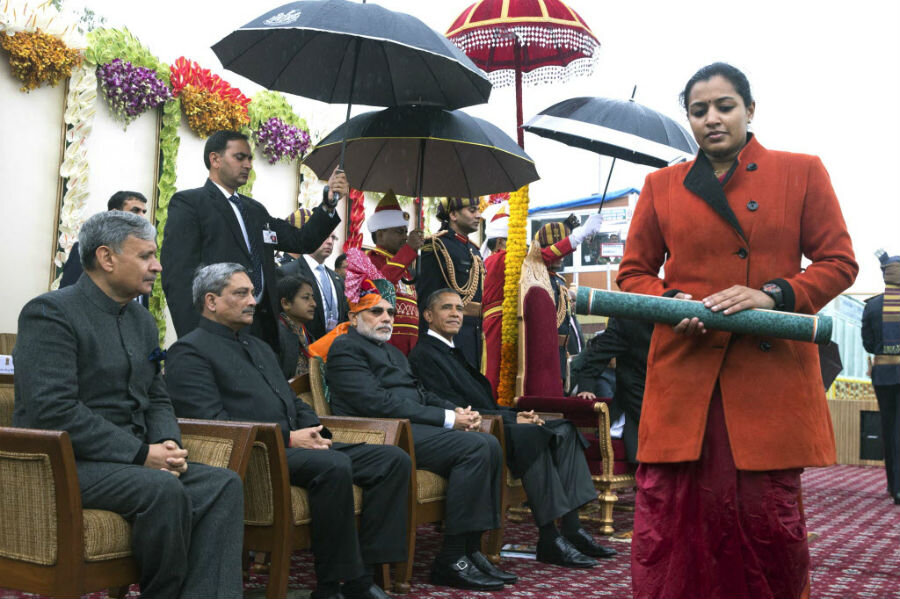Why India and US make eager, but awkward, dance partners
Loading...
| Washington
Toward the end of the Republic Day parade President Obama took in with India’s Prime Minister Narendra Modi in New Delhi Monday, the long formations of Russian-made military hardware gave way to newer made-in-USA weaponry and aircraft.
At the same time, the traditional parade celebrating India’s constitution showcased floats from every Indian state and a colorful variety of bands, acrobats, and children’s dance troupes – all symbolizing the diversity and energy of the world’s largest democracy.
Those two aspects of a parade Mr. Obama attended as Mr. Modi’s “chief guest” underscore why the president has put so much time into advancing relations between the United States and India. India is not only a cornerstone of Obama’s “Asia pivot,” boasting huge market potential and promising a key role in regional security.
But India’s success as a democracy also makes it a valuable alternative when compared with other major powers in the region, including a Communist China and an increasingly authoritarian Russia. As the US expands ties to other developing countries in the Asia-Pacific region, India can serve as a model of stability and democratic rule, both administration officials and regional experts say.
Obama “really values the US-Indian relationship both for its own sake and because he sees a clear role [India can play] in Asia in the future,” says Ashley Tellis, a senior associate specializing in Asian security issues at the Carnegie Endowment for International Peace in Washington. “That means looking at India in the context of wider relationships with other great powers, including China.”
And just as India figures prominently in Obama’s “rebalancing” of US interests to Asia, the United States is emerging for Modi as a key partner in his efforts to revitalize a stagnant economy and to reinforce India’s position in the region and on the global stage.
Inviting Obama to be the first US president to participate in India’s Republic Day celebrations “was Modi’s way of signaling the US really looms large in his calculations on where he wants to take India,” Mr. Tellis adds.
Still, Modi is not likely to take any steps that compromise India’s tradition of a firmly independent foreign policy. How he builds closer ties with the US while preserving India’s partnership with Russia will offer clues to India’s way forward, regional analysts say.
The growing presence of US military hardware among Russian-made tanks and other weaponry displayed in the parade is one clue to India’s evolution as a regional security power. Rather than a shift from one “camp” to another, India’s preference in recent years for American defense equipment suggests both an interest in acquiring the top technology available and a desire to diversify relations away from a traditional reliance on one power, security experts say.
Agreements that Modi and Obama signed during the visit also underscore the economic dimensions of closer defense ties. The two countries agreed on deals that will result in production of drones and airplane parts in India, and creation of joint research teams looking into new technologies for jet engines and aircraft carriers.
Indian officials are insistent, however, that their country’s embrace of the US under Modi does not suggest an alignment of the two countries’ foreign policies. Rather, they say, the two powers will cooperate more closely on emerging common interests, such as the security and open accessibility of Asia’s seas and trade corridors.
White House officials say the US and India see eye-to-eye on the need to keep Asia’s sea lanes open and secure for all. In particular, the two nations signed a joint statement in which they underscored the priority they both place on maritime security in the South China Sea.
Some read the statement as a prod to China to desist from its provocative actions in disputed Southeast Asian waters, but officials insisted it was more a statement of bilateral support for international rules.
“Nobody’s aiming for confrontation with China or trying to contain China,” Obama deputy national security adviser Ben Rhodes told reporters in New Delhi Monday. “At the same time the US and India are committed to a rules-based order. We just want to make sure that all countries are following the rules of the road.”
While that may be, it did not mean that Obama was able to coax Modi into supporting the US position on what it sees as an even more egregious attack on international order – Russia’s activity in Ukraine.
As Modi stood by stone-faced, Obama used a joint press conference of the two leaders to assail Russia’s latest actions in Ukraine – which he said range from arming separatists in their renewed “aggression” to Russian training of the anti-Ukrainian forces – and to threaten yet another round of Western sanctions.
Just a month ago Modi lauded the “friendship of unmatched mutual confidence” between India and Russia in a meeting with Russian President Vladimir Putin. And just last week he told visiting Russian Defense Minister Sergei Shoigu that their two countries enjoy a “time-tested special and privileged strategic partnership.”
Modi, who has rebuffed US efforts to see India back off its close ties to Russia, insists that Russia has legitimate interests in Ukraine that the world cannot simply ignore.
Indian officials say that, rather than seeing some deep contradiction in Modi’s embrace of both Obama and Russia, Americans should see the two perspectives as a declaration of the foreign-policy independence India will covet as it deepens its global relationships.
The good news there for the US, these officials say, is that as it guards that independence, India won’t be forming alliances with any other powers either.






